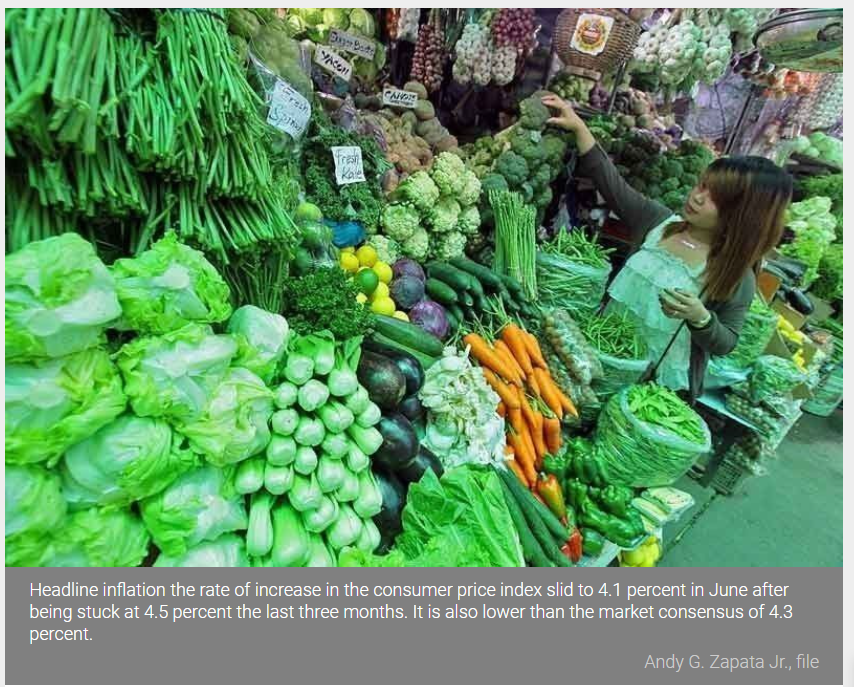Philippines: Inflation slows to 4.1% as transport costs ease
MANILA, Philippines — Price increases in basic goods and services eased in June, the slowest pace in six months, as transport costs decelerated with base effects fading from last year’s pandemic-related restrictions despite still elevated global oil prices.
Headline inflation the rate of increase in the consumer price index slid to 4.1 percent in June after being stuck at 4.5 percent the last three months. It is also lower than the market consensus of 4.3 percent.
However, it is much quicker than the 2.5 percent rate recorded in the same period last year.
While the June inflation was well within the 3.9 to 4.7 percent forecast of the Bangko Sentral ng Pilipinas for the month, it breached the two to four percent target for 2021. Year-to-date inflation averaged at 4.4 percent.
In a briefing yesterday, Philippine Statistics Authority (PSA) chief Dennis Mapa said the main source of slowdown in the June inflation was transport, which accounted for 95.4 percent of the overall downturn.
Transportation costs, which had a 19.2 percent share to the headline rate, rose by 9.6 percent, much slower than the 16.5 percent growth last year as base effects from pandemic-related rules for public transportation faded.
The PSA said fares, petroleum and fuels went down as the move to increase the carrying capacity in public transport contributed to the decline in fares even as oil prices remain elevated.
The heavily weighted food and non-alcoholic beverages posted a faster annual increment at 4.7 percent, from 4.6 percent the previous month.
Meat, a major contributor in the food category, slightly eased to 19.2 percent from 22.1 percent as the government’s decision to cut tariffs and increase imports slowly takes effect.
In fact, Mapa said prices of pork meat registered an average decline of P8 to P10 per kilogram last month. However, prices remain within the P320 to P350 per kilo level.
Despite the decrease in pork prices, fish price is another area of concern for inflation, especially as it increased to 8.7 percent from 7.8 percent in May.
“We are tracking the items that may affect the trend in inflation. We are seeing that fish has been increasing over the last months and it is a possible threat of the trajectory of our inflation,” Mapa said.
“And of course transport inflation is another potential threat. Fuel products have spillover effects on housing, water, electricity and gas components,” he said.
Also contributing to inflation were increases in the prices of housing, water, electricity, gas and other fuels, which had a 13.1 percent share of the headline rate. This was driven by rentals, liquefied petroleum gas (LPG) and electricity.
With inflation on a downtrend, Union Bank of the Philippines chief economist Ruben Carlo Asuncion said further decline is expected in the coming months, especially as meat supplies start to arrive in the country.
“But this view is not absent of risks as rising oil prices have to be flagged. Impact of oil prices increased pass-through. However, we expect it to be not the same pre-pandemic. We expect a more muted impact due still to a more subdued demand overall,” Asuncion said.
Rizal Commercial Banking Corp. chief economist Michael Ricafort said inflation could have already reached the peak of 4.7 percent in February as food prices eased due to non-monetary measures to boost local supply.
However, he warned that an offsetting risk factor for inflation include weak exchange rate that would gradually lead to some pickup in import prices and overall inflation.
“Other offsetting risk factors for inflation are higher electricity prices, global oil prices at new highs, relatively higher global commodity prices amid faster recovery in the global economy, especially in the US and in China,” Ricafort said.
The further downgrade of quarantine status in Metro Manila and nearby provinces can also contribute to upward movement of the inflation rate.
With inflation set to glide back within target in the coming months, ING Bank senior economist Nicholas Mapa expects the BSP to retain policy rates at two percent for the rest of the year and only consider adjusting policy by mid-2022.
“With price pressures fading, we expect inflation to decelerate in the second half of the year as meat prices normalize with authorities allowing higher import volumes for the commodity,” Mapa said.
“Base effects tied to social distancing guidelines for transport and other services are also likely to fade in the coming months, offsetting a projected acceleration in utility and fuel costs given the surge in global oil prices,” he said.
Ricafort, on the other hand, said inflation may pick up again during the typhoon season next month, only to return to easing around two to three percent by November.
Meanwhile, inflation in the National Capital Region eased to two percent while that of the areas outside NCR also slid to 2.7 percent.
On the other hand, consumer prices for the country’s poorest households eased as CPI for the bottom 30 percent income households decelerated to 4.3 percent. This brings the year-to-date average to 4.9 percent.
Slower growth was seen in the indexes of transport and alcoholic beverages and tobacco. Increments, however, were noted in food, housing, water, electricity and gas, among others.
Prices of consumer goods for the poorest households outside the NCR went down to 4.3 percent. Inflation in NCR also eased to 4.1 percent from 4.4 percent.
Source: https://www.philstar.com/business/2021/07/07/2110649/inflation-slows-41-transport-costs-ease


 English
English




